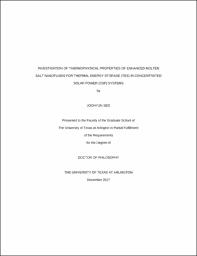
ATTENTION: The works hosted here are being migrated to a new repository that will consolidate resources, improve discoverability, and better show UTA's research impact on the global community. We will update authors as the migration progresses. Please see MavMatrix for more information.
Show simple item record
| dc.contributor.advisor | Koh, Seong Jin | |
| dc.creator | Seo, Joohyun | |
| dc.date.accessioned | 2020-01-14T23:43:04Z | |
| dc.date.available | 2020-01-14T23:43:04Z | |
| dc.date.created | 2017-12 | |
| dc.date.issued | 2018-01-16 | |
| dc.date.submitted | December 2017 | |
| dc.identifier.uri | http://hdl.handle.net/10106/28904 | |
| dc.description.abstract | Concentrated solar power (CSP) technologies have a great economical and technical potential for energy production in future. Its incorporation with thermal energy storage (TES) overcomes one of the biggest challenges in most renewable energy technologies, the intermittency of energy supply by natural resources. TES with 15-hour storage capacity is already commercialized to operate a CSP plant for 24 hours a day. When the sunlight is concentrated by mirrors into a small focal point, a heat transfer fluid (HTF) transfers the collected heat to a turbine or an engine to produce electricity and any surplus heat to a TES unit for later use. Typical CSP plants used two different materials for HTF and TES, and thus several heat exchangers were necessary between HTF and TES. These heat exchangers can cause a significant temperature drop and associated thermodynamic penalties. The potential capital cost increase is also not negligible.
Using a binary nitrate salt (termed as “solar salt”) as a single storage fluid for both HTF and TES can not only simplifies the heat transport/storage system but also minimize a potential energy loss. Its high-temperature stability (over 500 °C) can also increase the overall thermodynamic efficiency. However, solar salt has a relatively high melting point (220 °C), and it is likely to freeze under a harsh condition such as nighttime, rainy, or cloudy day. As a result, an auxiliary heater is required for a freeze protection and can significantly decrease the power output. Hence, it is necessary to investigate alternative storage fluid whose melting point is low enough to minimize the energy loss. A ternary nitrate salt mixture (LiNO3-NaNO3-KNO3) has a very low melting point (~100 °C). Using this mixture as a single storage fluid for both HTF and TES in a CSP can significantly reduce the energy loss by the freeze protection but also enhance CSP’s energy conversion efficiency. However, the heat storage density of these molten salts is typically low. Literature study shows that dispersing appropriate nanoparticles can enhance salts’ heat capacity. This can not only reduce the required HTF and TES amount, but also reduce the size of thermal transport and storage systems (e.g., pipes, heat exchanger, and storage tanks).
In this study, several commercial SiO2 nanoparticles were first dispersed into a ternary nitrate salt to see if it can enhance its effective heat capacity. Several SiO2 nanoparticles at different sizes were tested to investigate the effect of nanoparticle size. Fresh nanoparticles, then, were in-situ synthesized in a binary and ternary nitrate salts. Al(NO₃)₃·9H₂O (aluminum nitrate nonahydrate) and Mg(NO₃)₂·6H₂O (magnesium nitrate hexahydrate) were induced to decompose in a molten nitrate salt to produce Al2O3 and MgO nanoparticles. The new method (Liquid to Liquid) for the sample preparation was used to increase the enhancement of specific heat of a binary nitrate salt with SiO2 nanoparticle. A modulated differential scanning calorimeter (MDSC; Q20, TA Instrument Inc.) was used to measure the effective heat capacity. A discovery hybrid rheometer (HR-2, TA Instruments Inc.) was employed to measure the mixture’s viscosity. A customized apparatus was built to measure its effective thermal conductivity. A figure of merit analysis was performed to predict the performance of the mixture. A scanning electron microscope (SEM: Hitachi S-3000N and S-5000H) was used for material characterization. Moreover, molecular dynamics simulation was performed to investigate the effect of nanoparticles on the observed property measurements. | |
| dc.format.mimetype | application/pdf | |
| dc.language.iso | en_US | |
| dc.subject | Molten salt | |
| dc.subject | Thermal energy storage | |
| dc.subject | Heat transfer fluid | |
| dc.subject | Concentrated solar power systems | |
| dc.subject | Nanoparticles | |
| dc.subject | Enhanced molten salt nanofluid | |
| dc.title | INVESTIGATION OF THERMOPHYSICAL PROPERTIES OF ENHANCED MOLTEN SALT NANOFLUIDS FOR THERMAL ENERGY STORAGE (TES) IN CONCENTRATED SOLAR POWER (CSP) SYSTEMS | |
| dc.type | Thesis | |
| dc.degree.department | Materials Science and Engineering | |
| dc.degree.name | Doctor of Philosophy in Materials Science and Engineering | |
| dc.date.updated | 2020-01-14T23:45:15Z | |
| thesis.degree.department | Materials Science and Engineering | |
| thesis.degree.grantor | The University of Texas at Arlington | |
| thesis.degree.level | Doctoral | |
| thesis.degree.name | Doctor of Philosophy in Materials Science and Engineering | |
| dc.type.material | text | |
| dc.creator.orcid | 0000-0002-9778-132X | |
Files in this item
- Name:
- SEO-DISSERTATION-2017.pdf
- Size:
- 7.070Mb
- Format:
- PDF
This item appears in the following Collection(s)
Show simple item record


